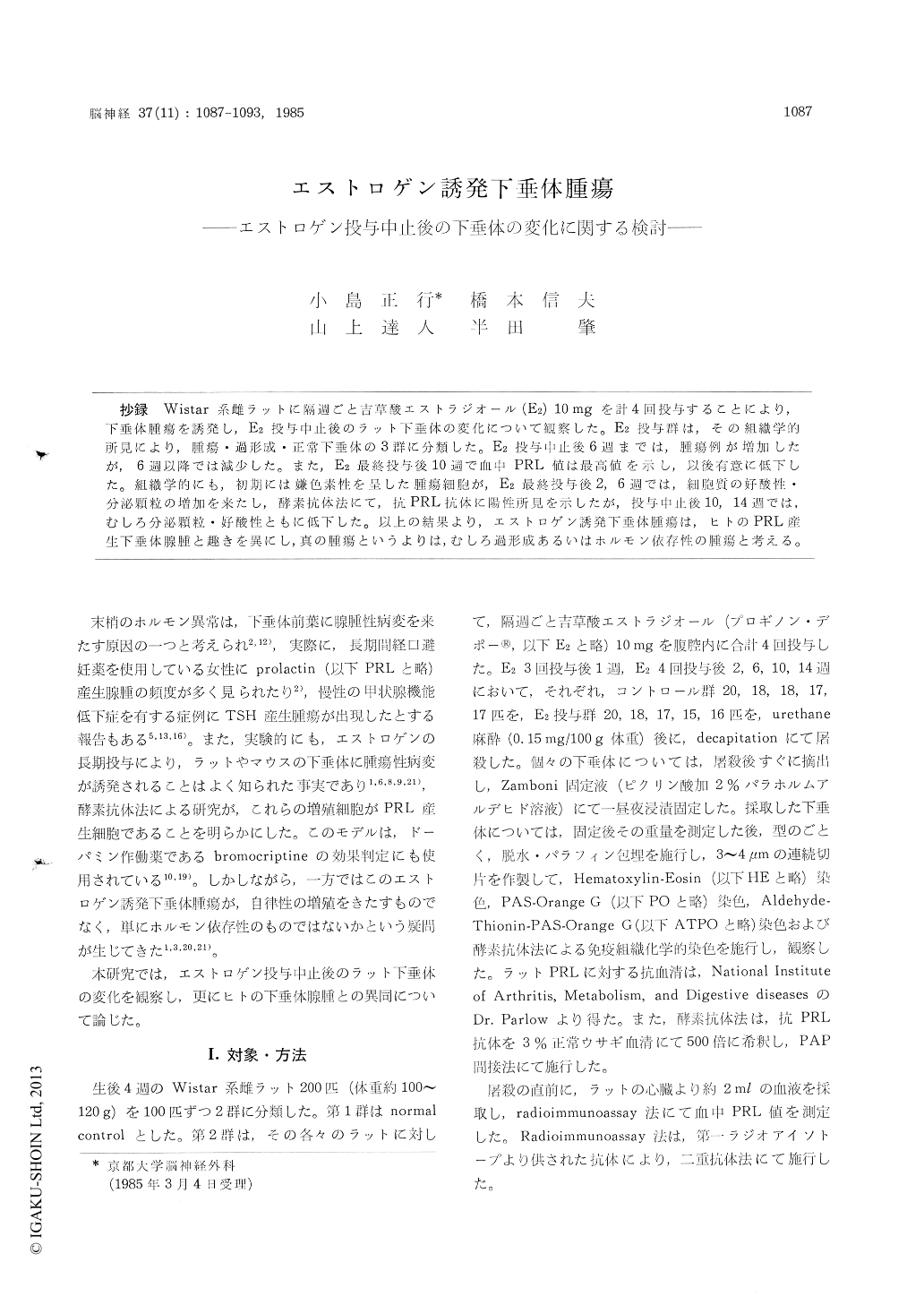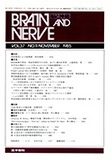Japanese
English
- 有料閲覧
- Abstract 文献概要
- 1ページ目 Look Inside
抄録 Wistar系雌ラットに隔週ごと吉草酸エストラジオール(E2)10 mgを計4回投与することにより,下垂体腫瘍を誘発し,E2投与中止後のラット下垂体の変化について観察した。E2投与群は,その組織学的所見により,腫瘍・過形成・正常下垂体の3群に分類した。E2投与中止後6週までは,腫瘍例が増加したが,6週以降では減少した。また,E2最終投与後10週で血中PRL値は最高値を示し,以後有意に低下した。組織学的にも,初期には嫌色素性を呈した腫瘍細胞が,E2最終投与後2,6週では,細胞質の好酸性・分泌顆粒の増加を来たし,酵素抗体法にて,抗PRL抗体に陽性所見を示したが,投与中止後10,14週では,むしろ分泌顆粒・好酸性ともに低下した。以上の結果より,エストロゲン誘発下垂体腫瘍は,ヒトのPRL産生下垂体腺腫と趣きを異にし,真の腫瘍というよりは,むしろ過形成あるいはホルモン依存性の腫瘍と考える。
Pituitary tumors were induced in female rats of Wistar strain by administration of estradiol valerate (E2) and the effect of estrogen withdrawal on E2-induced tumors were studied to elucidate the nature of the induced tumors. Ten mg of E2 was administered to 100 rats intraperitoneally once every 2 weeks, totally four times. Experimental animals were sacrificed at 1 week before, 2, 6, 10, and 14 weeks after stopping injection of E2.
1) The incidence of pituitary tumor and hyper-plasia (Table 1)
Pituitary glands in each animals were examined and were classified into three groups, namely pituitary tumor, hyperplasia, and normal gland according to histological findings. The incidence of pituitary tumors was highest in rats sacrificed 6 weeks after E2 withdrawal. Pituitary tumors became less frequent and hyperplasias and normal glands became more frequent in rats sacrificed thereafter.
2) Pituitary weight (Table 2, Fig. 1)
Irrespective of timing of sacrifice, the weight of pituitary gland (mean±SE) was 134±70 mg in the group which were judged as having a pituitary tumor, 38±17 mg in the hyperplasia group, and17±5 mg in the normal group, respectively. Pitui-tary weight of control rats were 12±3 mg. The tumor group had a significantly heavier pituitary weight than hyperplasia and normal groups (p <0.01).
In each group, there was no significant difference of pituitary weights between animals sacrificed at different intervals after E2 withdrawal.
3) Serum PRL level (Table 2, Fig. 2)
Serum PRL level (mean±SE) was 8513±5805 ng/ ml in the tumor group, 531±134 ng/ml in the hyperplasia group, 47 ±62 ng/ml in the normal group, and 10±7 ng/ml in the control group. Serum PRL level in the tumor group showed a signifi-cantly higher value than those of hyperplasia and normal groups (p<0.01).
In the tumor group, PRL level was highest at 10 weeks after E2 withdrawal and became lower thereafter.
The relationship between pituitary weight and serum PRL level was shown in Fig. 3. In eleven of 16 tumor cases in which pituitary weight ex-ceeded 100 mg, their PRL levels were over 10000 ng/ml. In cases with pituitary weight under 100mg, the weight had positive correlation to serum PRL level.
4) Histological changes of the lesions (Fig. 4-6)
In rats sacrificed at 2 and 6 weeks after E2 withdrawal, tumor cells which were chromophobic during estrogen administration became eosino-philic and had many intracytoplasmic secreting granules. These granules were stained with anti-rat PRL antibody. At 10 and 14 weeks after E2 withdrawal, tumor cells became chromophObic and secreting granules became less prominent.
5) Microadenomas
All the pituitary glands of E2-treated rats which were judged as hyperplasia or normal gland were examined carefully. Serial sections of these speci-mens did not show the presence of focal hyper-plasia or microadenomas.
These findings suggested that E2-induced pitui-tary tumors are different from human PRL produc-ing pituitary adenomas and they seem to be diffuse hyperplasia or hormone dependent tumors rather than genuine tumors.

Copyright © 1985, Igaku-Shoin Ltd. All rights reserved.


